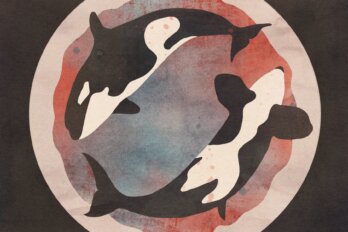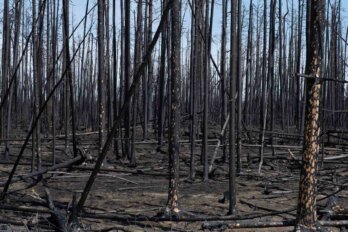The narrow route to Canada’s deep North widens past Inuvik and turns to ice. “Did you hear a crack? ” asks Kate, one of my companions on this journey to Tuktoyaktuk, a hamlet in the western Arctic. “No, did you? ” I answer, panicked. I’m ready to jump ship at seventy kilometres an hour and make for the tree-spiked banks of the Mackenzie River, whose meandering path the winter highway traces. Despite its impressive capacity (six transport trucks could drive it side by side), I know that nothing stands between us and oblivion but frozen water, glinting teal or cobalt depending on the slant of the light. “No,” Kate says with a grin. “Just checking.”
One kilometre down, 183 to go. Tuktoyaktuk is famous for being far away, the Canadian equivalent of Timbuktu. Hunched on a pockmarked peninsula that juts into the Beaufort Sea, the Inuvialuit community of roughly 950 is cloistered by water, ice, or tundra year-round. Few tourists venture to this cold edge of Canada, and fewer still can pronounce its name, which even the locals shorten to Tuk. One cheeky clothing franchise has rather successfully promoted a fictitious local university, abbreviated on sweatshirts to “Tuk-U.”
So far just a joke, a university here might not seem so preposterous if the place develops as the Canadian government hopes it will. By a few weeks, we missed seeing Prime Minister Stephen Harper, pink nosed in the polar chill, mark the groundbreaking on an all-season highway that will link Tuktoyaktuk to Inuvik and, by extension, the rest of the world. This project will realize former PM John Diefenbaker’s vision of “roads to resources”: throughways snaking from sea to sea to shivering sea, driving economic development to the Arctic—mainly through resource extraction—while asserting the region’s unalloyed Canadianness. Though construction has begun, a finished highway is at least four years and $300 million away. For now, a lone road leads to Tuktoyaktuk, and only in winter. I’ve come here to drive it while I still can.
The terrain is bare and wind peeled, in all respects unearthly. No wonder scientists come to Tuktoyaktuk to better understand Mars, another cold, treeless place dotted with pingos, ice-cored hills heaved skyward by repeated freeze-thaw cycles. I spot two on the horizon, ivory and blistered, like the backs of surfacing belugas. The hamlet finally materializes as a colony of prefab homes and metal warehouses on pilings, a permafrost construction strategy. Meanwhile, the bed and breakfast I had tried to book wasn’t returning my calls. “No problem. We can stay at my friend Nellie’s,” says my other companion, Zoe, who lives in Inuvik. She directs us to a two-storey home nearby.
Inside, the wood-panelled living room is decorated with African masks, Asian wall art, and a framed picture of Queen Elizabeth with an earnest-looking woman in glasses. Our host, it turns out, is Nellie Cournoyea, former premier of the Northwest Territories, though she is away when we visit. “Everyone knows everyone up here,” Zoe explains. This small-town feel can help build community—people look out for each other—but is nepotistic at times. The former mayor of Tuktoyaktuk, Merven Gruben, lobbied hard for the Inuvik–Tuk highway; he also co-owns the company that won a multimillion-dollar contract to build it.
Whether because the road stands to profit a powerful few; because it will pass within littering distance of the Husky Lakes, sacred territory for the Inuvialuit; or because locals have been promised other developments that haven’t delivered (think the Mackenzie Valley Pipeline), some people are reluctant to speak about it. They shrug their shoulders, voice hopes for jobs and cheaper groceries, and switch to a less controversial subject, like climate change.
“We have birds I’ve never seen before,” notes Leonard Kuptana, an elder. “All kinds of creatures that don’t belong this far north.” He describes spiders that leap like ninjas, or ones easily confused for stones until they scuttle away. “Oh, and Courtney Love slept here once,” he adds with a wink. He is referring, of course, to the rock spectacle Molson mounted almost twenty years ago to promote its new ice beer. The brewery spent $10 million on a concert with Hole and Metallica and next to nothing on security. Who would crash it?
In Aklavik, farther inland and upriver, Tuktoyaktuk’s highway is a sore point for somewhat different reasons. “We’ve lobbied for a road since the ’70s,” says Dean Arey, a local foreman. “Why Tuk? Why not Aklavik? ” Cruising the streets, the only traffic we meet is a hooded teenager on a Ski-Doo. This sleepy hamlet served as the territorial government’s administrative hub until the ’50s, when it was deemed too flood prone to support a major airport. Supporting a major anything in the Arctic is like maintaining a moon base: the limited carrying capacity means population hubs must rely on resources from the South. Undaunted, the government abandoned Aklavik in favour of Inuvik, an artificial community to the east, and encouraged residents to follow suit. Sixty years later, the big jets land in Inuvik, oil money flows toward the Beaufort Sea, and a few stubborn families insist that they’ll remain in Aklavik come hell or high water. The municipality’s official motto is Never Say Die.
We start on the long trip back to Inuvik at dusk. The wheels purr on ice plastered with snow. In the overcast light, I can barely see where the road ends and the riverbanks begin. When darkness falls, the sky develops a peach fuzz sheen. “Northern lights? ” wonders Kate. But around the bend, we realize that the glow comes from Inuvik’s city lights, refracted by clouds. I try to imagine this electromagnetic shimmer spreading to Tuktoyaktuk and beyond—a new kind of aurora borealis beamed up from highways and homes, oil rigs and mining camps, concert halls and university campuses. We exit the winter highway into downtown Inuvik, the gas tank nearly empty, the tires biting into gravel, and I can’t shake the feeling that I’m driving on thin ice.
This appeared in the June 2014 issue.





